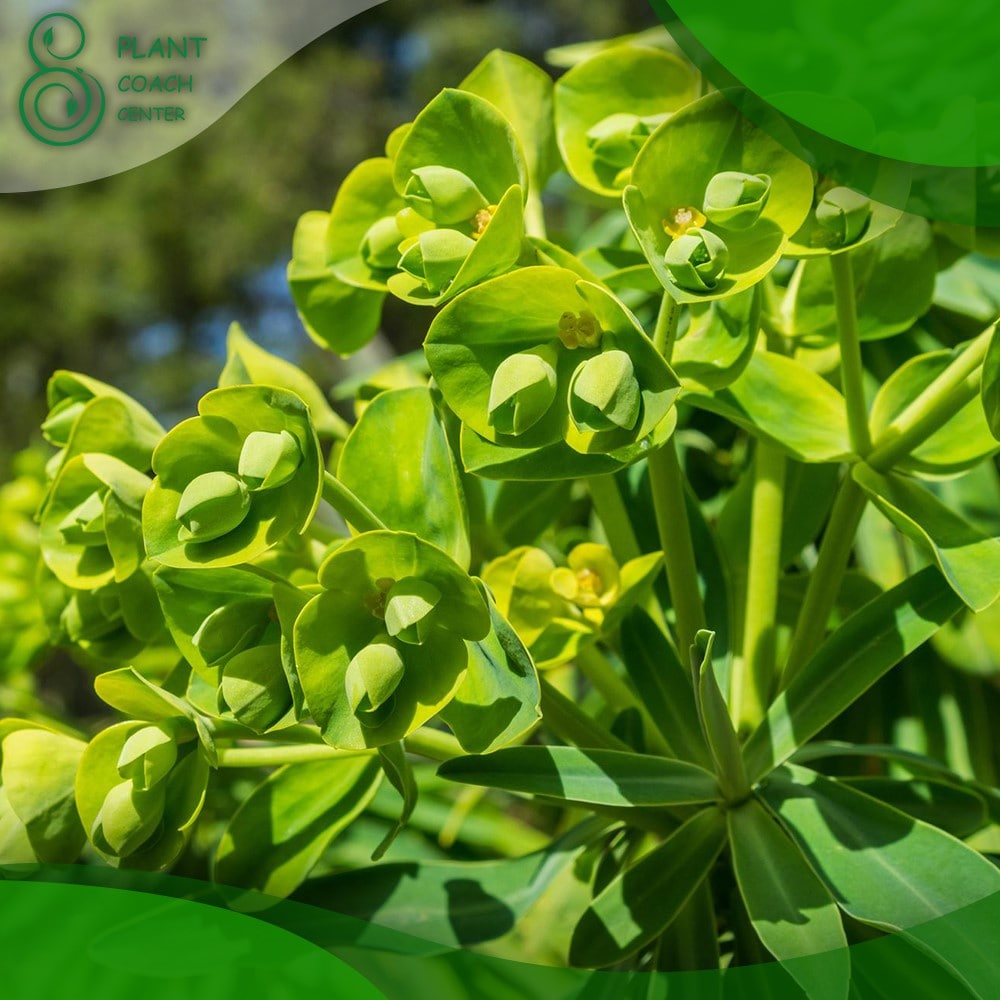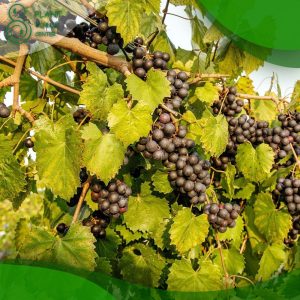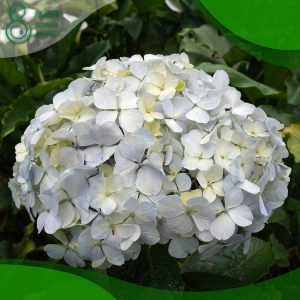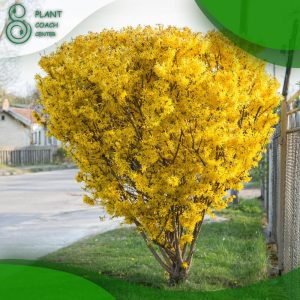When to Cut Back Euphorbia
Euphorbia, a diverse genus of flowering plants, comprises thousands of species known for their unique shapes, sizes, and textures. As a plant coach, understanding the growth patterns and needs of Euphorbia is crucial to ensure their health and vitality. In this comprehensive article, we will delve into the art of pruning Euphorbia and how to identify the right time for it.
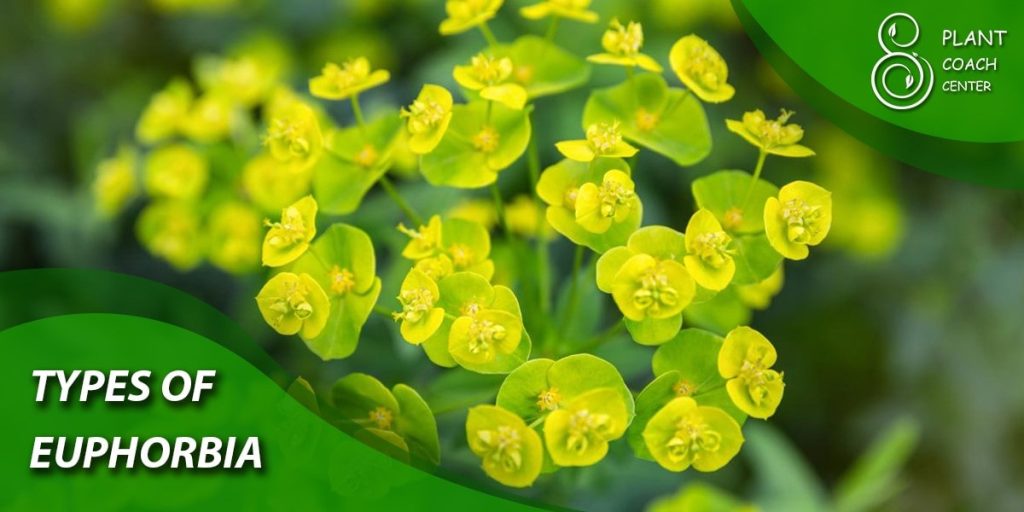
Types of Euphorbia
Euphorbia plants come in various types, each with its own distinct characteristics and care requirements. Some of the common Euphorbia species include:
- Euphorbia milii: Also known as Crown of Thorns, features colorful bracts and thorny stems. It is native to Madagascar and is a popular houseplant known for its resilience and striking beauty.
- Euphorbia trigona: A striking succulent with triangular green stems and red edges. Native to Central Africa, this Euphorbia is admired for its architectural appearance and low-maintenance nature.
- Euphorbia characias: An ornamental perennial with blue-green foliage and showy flowers. This Mediterranean native is valued for its ability to add vibrant colors to garden landscapes.
The Importance of Pruning Euphorbia
Pruning is a vital aspect of Euphorbia care, as it offers several benefits for the plant’s overall health and appearance:
- Encourages Growth: Pruning stimulates new growth and branching, leading to a fuller and more vibrant plant. Regular pruning helps maintain the plant’s shape and prevents it from becoming overly leggy or unruly.
- Shape and Aesthetics: Euphorbia plants often have unique and eye-catching forms that can be enhanced through careful pruning. Trimming away unsightly or damaged growth improves the plant’s overall aesthetics.
- Disease Prevention: Removing dead or diseased parts of the plant helps prevent the spread of infections and pests, safeguarding the health of the entire plant.
- Flowering Enhancement: For many Euphorbia species, proper pruning can lead to improved flowering and longer-lasting blooms. By cutting back spent flowers and encouraging new growth, you can enjoy a more abundant display of blossoms.
Identifying the Right Time for Pruning
Timing is crucial when it comes to pruning Euphorbia. Different seasons and signs indicate when it’s best to cut back your plants:
Seasonal Considerations
- Pruning in Spring: Spring is generally the best time for major pruning as the plant enters its active growth phase. By pruning in early spring, you give the Euphorbia ample time to recover and put forth new growth during the growing season.
- Pruning in Summer: Light pruning can be done during summer to maintain the shape and remove dead blooms or damaged parts. Be cautious not to over-prune during the hot months, as this can stress the plant.
- Pruning in Fall: Avoid heavy pruning in the fall, as the plant is preparing for winter dormancy. Light maintenance pruning to remove dead or damaged growth is acceptable, but major pruning should wait until spring.
- Pruning in Winter: Minimal pruning is recommended during winter, as the plant is dormant and vulnerable. However, if there are any severely damaged or diseased parts, it is best to remove them to prevent further issues.
Signs That Indicate Pruning is Needed
In addition to considering the season, specific signs and growth patterns indicate when pruning is necessary:
- Overgrowth: If the Euphorbia is becoming leggy or too large for its space, pruning can help manage its size and maintain a compact shape. Overgrown Euphorbias can become top-heavy and unstable, so regular pruning is essential for their overall health.
- Dead or Damaged Growth: Prune away any dead, diseased, or damaged parts of the plant as soon as you notice them. These sections not only detract from the plant’s appearance but also provide entry points for pests and diseases.
- Pests and Diseases: Infestations or infections can weaken the Euphorbia and affect its growth. If you notice signs of pests or diseases, consider pruning the affected areas and taking appropriate measures to treat the issue.
- Flowering Patterns: Understanding the flowering habits of specific Euphorbia species can guide pruning for optimal blooms. Some Euphorbias produce flowers on new growth, while others bloom on older stems. By knowing the flowering pattern, you can time your pruning to encourage abundant blooms.
Euphorbia Pruning Techniques
Proper pruning techniques are essential to ensure the health and appearance of your Euphorbia. Consider the following guidelines:
- General Pruning Guidelines:
- Always use sharp and clean pruning tools to minimize stress on the plant and prevent the spread of diseases.
- Make clean cuts just above leaf nodes or lateral branches to encourage new growth in the right direction.
- In the case of Euphorbia milii and other species with latex sap, wear gloves and be cautious to avoid contact with the sap, which can cause skin irritation.
- Tools Required for Pruning:
- Pruning shears: Ideal for small branches and stems.
- Loppers: Suitable for thicker stems or branches that require more cutting force.
- Gloves: Protect your hands from thorns or latex sap, especially when dealing with spiny Euphorbia species.
- Different Techniques for Different Euphorbia Types:
- Cutting Back Euphorbia Milii: Euphorbia milii can become leggy over time, and regular pruning can encourage branching and bushier growth. Trim back long, leggy stems, cutting just above a leaf node to promote new growth. Additionally, prune away spent flowers to redirect energy towards new blooms.
- Pruning Euphorbia Trigona: Euphorbia trigona is a succulent that can grow quite tall and narrow. To maintain its shape and prevent it from becoming too top-heavy, prune the top or sides of the plant. Use sharp shears to make clean cuts and wear gloves to protect against the plant’s sap.
- Trimming Euphorbia Characias: Euphorbia characias produces tall flower stalks with striking flowers. After blooming, you can cut back the flower stalks to tidy up the appearance of the plant. Additionally, prune any old or damaged growth in early spring to encourage new shoots and maintain a healthy plant.
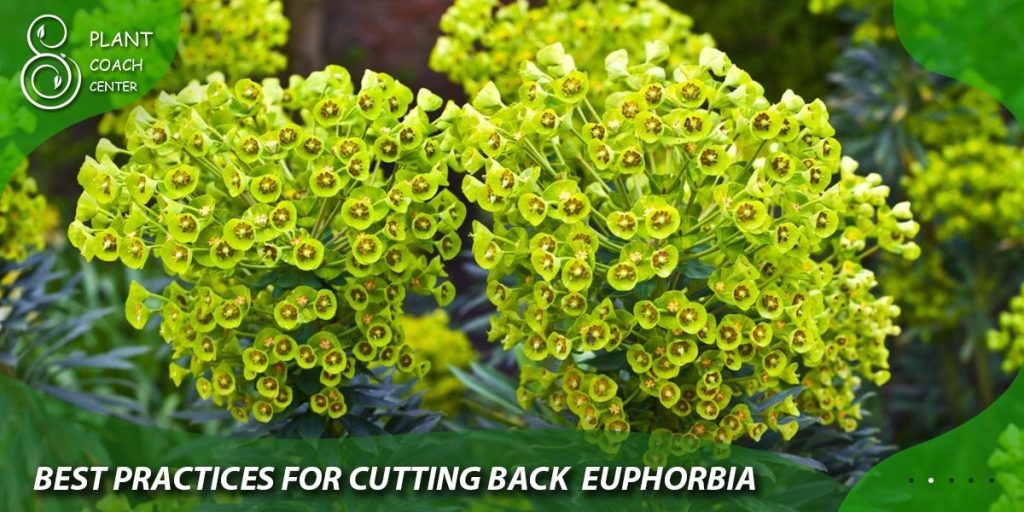
Best Practices for Cutting Back Euphorbia
Proper preparation and care during pruning ensure the best results and minimize stress on the plant:
- Preparing the Plant for Pruning:
- Water the Euphorbia a day or two before pruning to ensure it is well-hydrated and can better withstand the pruning process.
- If the plant has become overgrown or dense, consider thinning out some of the growth before making any major cuts.
- Step-by-Step Pruning Process:
- Assess the plant’s needs: Take a close look at the Euphorbia and identify areas that require pruning. Look for dead or damaged stems, crowded areas, or branches that are growing in undesirable directions.
- Use appropriate pruning tools: Select the right tools for the specific pruning tasks. Ensure that your pruning shears or loppers are sharp and clean to make precise cuts.
- Make clean cuts: When pruning, cut just above a leaf node or lateral branch to encourage new growth in the desired direction. Avoid leaving stubs, as they can lead to rot or attract pests.
- Dispose of pruned material carefully: Collect and dispose of the pruned material properly. Do not leave it around the plant, as it may harbor pests or diseases. Consider composting or disposing of the material in a green waste bin.
- Post-Pruning Care Tips:
- After pruning, monitor the Euphorbia closely for a few weeks to ensure that it is recovering well. Keep an eye out for any signs of stress, such as wilting or discoloration.
- If the Euphorbia was pruned heavily, avoid fertilizing it immediately after pruning. Allow the plant time to recover before introducing any additional nutrients.
- Continue regular care, including proper watering, sunlight exposure, and pest management, to support the plant’s recovery and growth.
Addressing Common Euphorbia Problems
Euphorbia plants are not immune to problems, but timely and proper pruning can help mitigate them. Here are some common issues and how to address them:
Dealing with Pest Infestations
- Identifying Pests: Look out for common pests like aphids, mealybugs, and spider mites on your Euphorbia. These pests can cause wilting, leaf discoloration, and damage to the plant’s overall health.
- Natural Remedies: For minor infestations, consider using natural remedies such as neem oil or insecticidal soap. These solutions are safer for the plant, beneficial insects, and the environment.
- Pruning for Pest Control: If pests have heavily infested certain parts of the plant, consider pruning and disposing of the affected areas to prevent further spreading. This is especially important for Euphorbia species that have multiple stems, as pests may concentrate on specific parts of the plant.
Managing Diseases in Euphorbia
- Identifying Diseases: Keep an eye out for signs of fungal infections, such as wilting, discoloration, or mold on the plant’s stems or leaves. Fungal diseases can spread quickly in humid or wet conditions.
- Preventive Measures: To prevent fungal diseases, ensure proper drainage in the soil and avoid overwatering. Providing adequate air circulation around the plant also helps reduce the risk of fungal growth.
- Pruning Diseased Parts: If a section of the Euphorbia is affected by disease, prune it promptly and sterilize the pruning tools afterward to prevent spreading the disease to other parts of the plant. Dispose of the pruned material carefully to prevent contamination.
Preventing Overwatering and Underwatering
- Monitoring Water Needs: Understand the water requirements of your specific Euphorbia species. Some Euphorbias, like those with succulent characteristics, are adapted to dry conditions and prefer infrequent watering.
- Proper Watering Technique: Water the plant thoroughly but allow the soil to dry out between waterings to prevent root rot. Overwatering is one of the leading causes of Euphorbia decline, so it’s essential to strike a balance with watering frequency.
- Pruning to Revive the Plant: If your Euphorbia is suffering from overwatering and has developed root rot or wilting, consider pruning away affected roots and stems to encourage new, healthy growth. Adjusting the watering schedule and ensuring proper drainage can also help the plant recover.
Troubleshooting Growth Issues
- Leggy Growth: If your Euphorbia becomes leggy or sparse, pruning back some of the excessive growth can encourage bushier growth. Focus on cutting back long stems to promote branching.
- Stunted Growth: Stunted growth in Euphorbia can be a result of several factors, including inadequate light, poor soil conditions, or improper care. Assess the plant’s growing conditions and make adjustments as necessary.
- Improper Flowering: The lack of flowering in certain Euphorbia species can be attributed to various factors, such as insufficient light or inadequate nutrients. Pruning can sometimes stimulate flowering, but ensuring the plant’s overall health and providing the right growing conditions are essential for consistent blooms.
Euphorbia Propagation Techniques
Expanding your Euphorbia collection is a rewarding experience, and propagation can be achieved through various methods:
- Propagating from Cuttings: Euphorbia plants are often propagated through stem cuttings. Choose healthy, mature stems and allow the cut ends to callus before planting them in well-draining soil. Avoid watering the cuttings too frequently to prevent rotting.
- Growing Euphorbia from Seeds: Some Euphorbia species produce seeds that can be collected and sown to grow new plants. Each species has its specific germination requirements, so be sure to research the particular species you are propagating.
- Division and Offsets: Some Euphorbia species naturally produce offsets or pups that can be separated from the parent plant and replanted. This method is especially common in species that form clumps or clusters of stems.
It’s important to note that some Euphorbia species produce latex sap, which can be toxic and irritating to the skin. When handling these plants for pruning or propagation, wear gloves and take precautions to avoid direct contact with the sap.
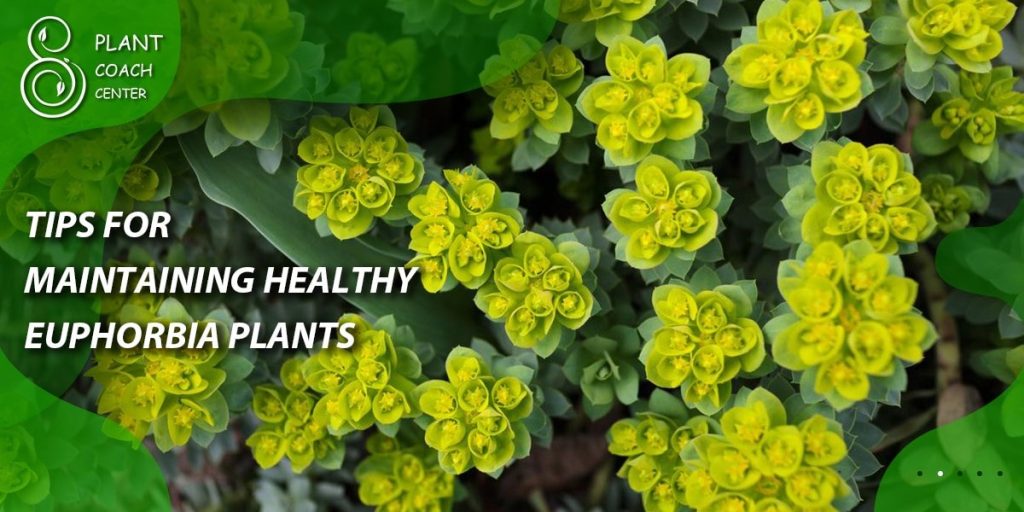
Tips for Maintaining Healthy Euphorbia Plants
To ensure your Euphorbia thrives, consider these essential care tips:
- Soil and Fertilizer Requirements:
- Euphorbias prefer well-draining soil that replicates their natural habitat. A sandy, succulent-specific potting mix or a cactus mix is suitable for most species.
- Use a balanced, low-nitrogen fertilizer during the active growing season. Fertilize sparingly, as Euphorbias are adapted to nutrient-poor environments.
- Sunlight and Temperature Considerations:
- Most Euphorbia species prefer bright indirect sunlight but can tolerate partial shade. Some species, like Euphorbia trigona, can tolerate direct sunlight, but it’s best to introduce them to direct sun gradually to avoid sunburn.
- Euphorbias are generally adaptable to a wide range of temperatures. However, it’s essential to avoid exposing them to frost or extreme cold, as many species are sensitive to freezing temperatures.
- Watering Schedule:
- Allow the soil to dry out between waterings, but avoid letting it completely dry for extended periods. Overwatering can lead to root rot and other issues.
- Adjust your watering frequency based on the specific Euphorbia species, the size of the pot, and the environmental conditions. Water more frequently during the growing season and reduce watering in the dormant winter months.
- Pest and Disease Management:
- Regularly inspect your Euphorbia for signs of pests or diseases. Early detection and prompt action can prevent the problem from spreading and save your plant.
- If you notice any pests or diseases, treat them with natural or organic remedies whenever possible, as Euphorbias can be sensitive to chemical treatments.
Euphorbia Varieties Suitable for Indoor Cultivation
While many Euphorbia species thrive outdoors, some are well-suited for indoor environments, bringing a touch of nature into your home:
- Choosing the Right Indoor Euphorbia:
- When selecting an indoor Euphorbia, consider species that can adapt to the indoor environment and don’t grow too large for your available space. Euphorbia tirucalli (Pencil Cactus) and Euphorbia milii (Crown of Thorns) are popular choices for indoor cultivation due to their manageable size and low-maintenance nature.
- Indoor Plant Care and Pruning Tips:
- Provide ample light for indoor Euphorbias. Place them near a south-facing window with filtered sunlight or use artificial grow lights if natural light is limited.
- Ensure good air circulation around the plant, as indoor environments can sometimes be more stagnant than outdoor spaces. Avoid placing the Euphorbia in drafty areas or near air conditioning vents.
Euphorbia in Landscaping
Incorporating Euphorbia into your garden or landscape can add striking visual interest and unique focal points:
- Euphorbia in Garden Design:
- Euphorbias can be used as accent plants in various garden designs, including rock gardens, succulent beds, or desert-themed landscapes.
- Consider pairing Euphorbia with other drought-tolerant plants that complement its unique form and color.
- Landscaping with Euphorbia for Aesthetics and Functionality:
- The striking shapes and colors of Euphorbia can create stunning focal points in garden beds and container arrangements.
- Euphorbia can also serve as an effective deterrent to unwanted wildlife in gardens, thanks to its latex sap and thorny stems.
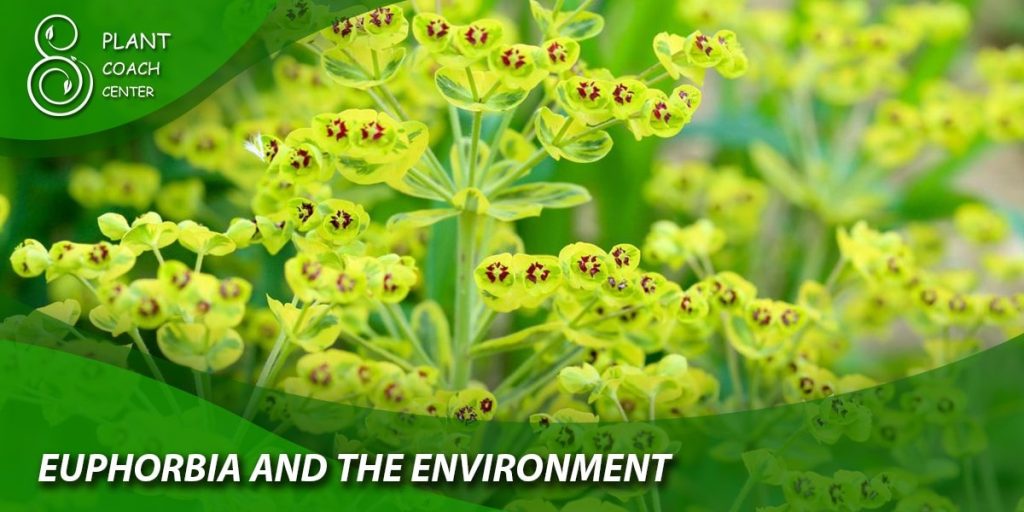
Euphorbia and the Environment
Understanding the ecological importance of Euphorbia is crucial for conservation efforts and maintaining biodiversity:
- Euphorbia’s Ecological Importance:
- Many Euphorbia species play important roles in their native ecosystems, providing valuable habitat and food sources for various wildlife, including insects and birds.
- Some Euphorbias have developed unique adaptations to survive in harsh environments, making them essential components of their respective ecosystems.
- Euphorbia and Wildlife:
- Depending on the species, Euphorbias can attract pollinators such as bees and butterflies, contributing to the pollination of other plants in the area.
- Some Euphorbia species produce seeds that are dispersed by animals, helping to spread plant diversity in their surroundings.
Conclusion
Properly pruning your Euphorbia is an essential aspect of plant coaching that contributes to the overall health and appearance of these unique plants. Understanding the right timing, techniques, and care requirements ensures that your Euphorbia thrives and graces your living spaces and gardens with its beauty and charm.
By following the guidelines and best practices provided in this comprehensive article, you can enjoy a flourishing and vibrant Euphorbia collection that brings joy and admiration to both indoor and outdoor spaces. Happy gardening!
Can I prune my Euphorbia in winter?
While minimal pruning can be done in winter, it's generally best to avoid major pruning during this time, as the plant is dormant and may be more susceptible to damage.
How often should I fertilize my Euphorbia?
Euphorbias don't require frequent fertilization. During the growing season, fertilize once a month with a balanced, diluted fertilizer. Reduce or stop fertilizing during the winter months when the plant is dormant.
Why is my Euphorbia not flowering?
Several factors can contribute to a lack of flowering in Euphorbias. Insufficient light, inadequate nutrients, and improper pruning practices can all impact flowering.


